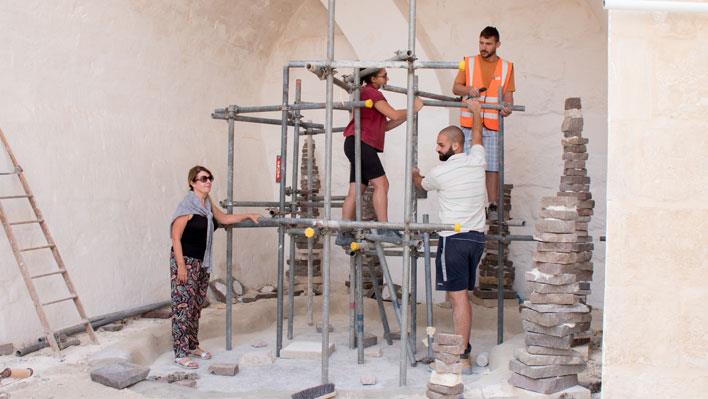The Malta International Contemporary Art Space (MICAS) is a new concept founded with the aim of strengthening Malta’s cultural infrastructure by providing a platform for contemporary art and internationalization. Through MICAS, Malta aims to become a new proactive player in the world of contemporary art.
It will be doing so out of its new base; the Ospizio and Ritirata in Floriana. This building, left derelict and somewhat crumbling over the past years, will be given a new lease of life and transformed by MICAS. The project itself is led by the Restoration Directorate which is taking advantage of its vast experience in past restorations to bring this area to life.
The Malta Independent met MICAS’ Art Director Ruth Bianco and one of the lead architects responsible for the restoration and new design, Claude Borg, on behalf of the Restoration Directorate to learn more about the site and about the new Contemporary Art Space that will open in it.
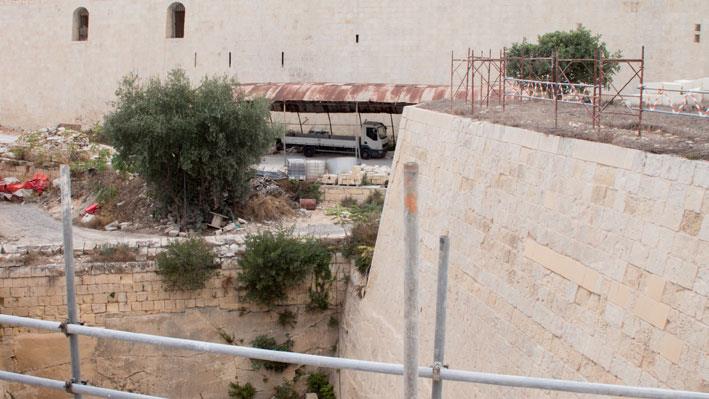
From gunpowder store, to hospice and other uses, to military workshop, to art space – A look back in time at the Ospizio
The Ospizio area is part of a sprawling complex of buildings and fortifications that dates back to the time of the Knights of St John, and characterizes one of their most complex builds on the island. The site has a long chronology and chequered history, with what is today known as the Ospizio initially starting life as a polverista – or gunpowder store.
Designed by the military engineer Blondel des Croisettes in 1665, the building had three windmills for grinding and manufacturing the gunpowder and was fully functional by 1667. By the 1700s however, this industry had moved further inland so the polverista was repurposed into the first state institution aimed at accommodating the elderly in 1729. However, they proved to be not quite fit for purpose, being rather dark and gloomy with two lower level basements that were too small to satisfy the demand. In 1732, Grand Master de Vilhena added new buildings to the site, as well as a fountain. The new improved hospice or Casa di Carità housed around 380 residents a year.
The institution became formally known as l’Ospizio in 1785 when Grand Master de Rohan issued a set of regulations for the management of the institution, which remained in place until 1816.
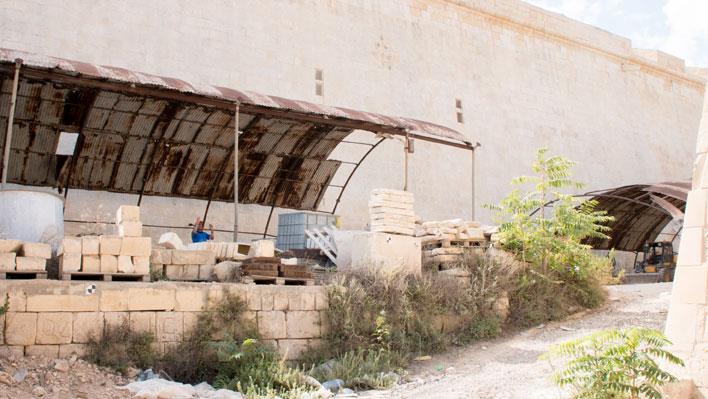
During the Napoleonic period, penitents – or reformed prostitutes – from the Magdalen Asylum at Lower St Elmo, Valletta, were transferred to the Ospizio, and when the British took over the islands, foundlings and female prisoners were also relocated here. The Ospizio basically became a multipurpose institution that had to cater for the elderly, orphans, illegitimate children, abandoned infants, the mentally ill and female prisoners.
Its use remained such until the present day St Vincent De Paule residence was opened in 1892, which served the same purpose. The Ospizio was closed and then transferred to the British Army Ordinance Department. During the First World War, when Malta received thousands of wounded from the Mediterranean theatre of war, the Ospizio workshops were transformed to manufacture hospital furniture and other medical items such as splints and crutches.
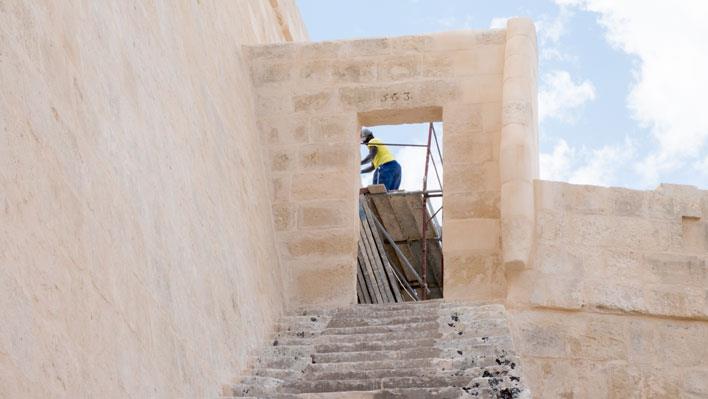
Its use changed again during the Second World War, and the bastions surrounding it were stacked with gun emplacements. As a result, the Ospizio was hit during enemy air raids targeting the Floriana barracks, Msida Creek and Manoel Island on the Marsamxett Harbour side. In 1964, when Malta attained independence, the British forces gradually began to hand over the now military buildings to the Maltese government. Indeed, by the early 1970s the Ospizio complex served as a store for Enemalta and also housed a trade school. In 1997, the Restoration Directorate set up its offices in the casemated vaults of the Polverista Curtain and in 2017 the MICAS administrative offices were housed in the old Polverista buildings as well.
The next step for the Ospizio is indeed yet another transformation; what was once a military complex will now be changed into one of culture. Bianco calls it a revival, repurposing and recycling of what is a forgotten site; a transformation from a war machine to an art machine.

Enabling the revival – the restoration of the Ospizio
The MICAS project is divided into four inter-linked phases, Borg explains. The first of those phases is the restoration of the area itself. Borg explains that the restoration process, which is currently ongoing, will be doing everything to retain as much of the original building as possible.
The case of the Ospizio is a curious one; Bianco describes the place as having layers of time over it. Indeed, the original structure built by the Knights has been subject to numerous modifications by its later occupiers, namely the British military. This presents certain a uniqueness in the place; one where two wars 400 years apart met and joined together.
From the restoration that has been completed thus far however, it is clear that everything is being done to bring both these periods seamlessly together. The San Salvatore rampart for instance has been retained and perfectly restored. However, the traverse circles of the old British gun emplacements situated on the bastion have been kept, as has the stonemasonry technique, where the bricks making up cannon openings within the ramparts were intertwined together, that the British employed to reduce potentially fatal rock shrapnel.
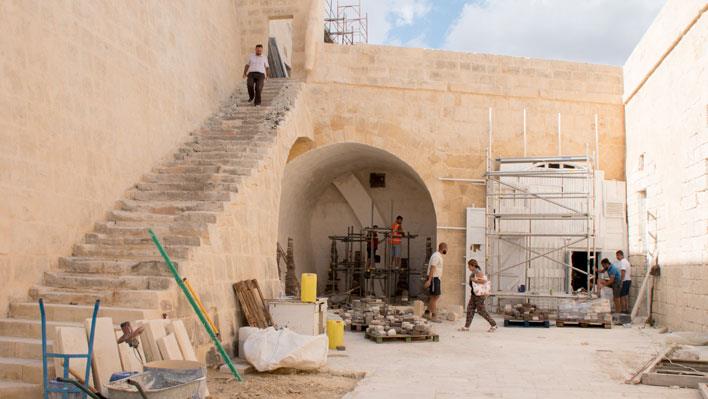
Other key features will also be retained and given prominence, the primary one being a magnificent Arco Barbara. The Arco Barbara is what is called a skew arch, and takes its name from its creator, the Maltese architect and military engineer Giovanni Barbara. Barbara was the Capomastro delle Opere della Religione – the principal architect of the Order – from 1681 right up to his death in 1728. The arch, built two years before his death, was Barbara’s greatest masterpiece, and it is one of only two in existence in Malta – the other being a much smaller skew arch in Qormi. Barbara’s masterpiece will be a key part of the space’s internal gallery, wowing visitors daily.
Another part of the ramparts that will be re-purposed during the restoration process are the currently darkened tunnels inside the bastions. The tunnels will be restored and used as connection paths between different parts of the complex. The fact that they are to be used as a connection within the complex is ironic, Bianco and Borg explain, because of their original intention. Indeed, at intervals, the side of the path opens into rooms. These rooms were in actual fact counter-mines. The idea of a counter-mine is that in the case of invasion, these rooms would be filled with explosives and if the enemy were to take the said part of the rampart above, the room would be blown up to isolate them onto that rampart. Bianco explains the irony; a path that was initially intended to break connections and bring isolation, is now actually going to be doing the opposite once the space is opened.
The restoration however will also be integrating new factors that have come to characterise modern day planning; factors such as the need for accessibility. Borg explains how they want to try to give better accessibility, something which is always very tricky as one must install large machines like lifts. Borg points out one case however, where they are improvising to make sure the whole area is accessible; he indicates a corner where the bastion has been lowered, either by deterioration or by war damage, and explains that the wall will be consolidated but left at its current height. This would allow for a lift to be placed there and access to the uppermost part of the bastion given to wheelchair users for the first time ever.
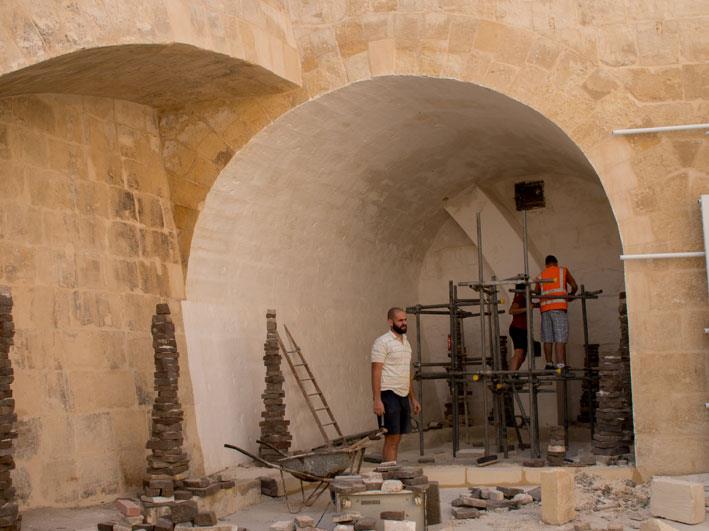
MICAS – An innovative space for the arts
Contemporary art is all multi-disciplinary, Bianco explains, and this means that a space for contemporary art has to be as flexible as possible. This need for flexibility has been transferred into how the Ospizio complex is being transformed.
The centrepiece of the complex is without doubt a large internal gallery in the area of the Arco Barbara. The gallery, which currently is an open area, will be roofed over in such a manner that it does not take away from the surroundings – the iconography is already present within the old, Bianco explains. An Italian consortium, IPO Studio, is being drafted in specifically for the building of this roof and the entire phase three – but other than that the design and implementation of the project and other phases is down to the Restoration Directorate and architects like Borg. All the phases of the project are being led by the Director of the Restoration Directorate Norbert Gatt.
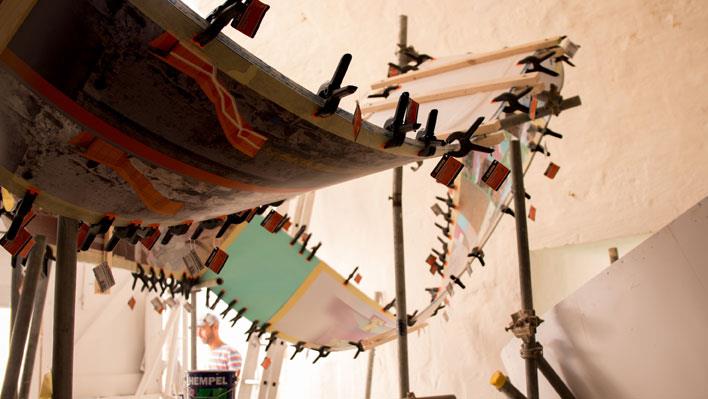
The internal gallery itself will be all about flexibility. First of all, the height of the hall varies – starting at 17 metres high and arching down to a height of five and a half metres. Furthermore, there will also be the possibility to attach partition walls to the roof of the gallery – Bianco calls them ‘moving walls’ – to create an even more flexible space. Contemporary art, Bianco explains, is multi-disciplinary – you can have for instance a sound installation; there is a merging between art and architecture as well for instance.
The space isn’t confined to the indoors however; there will also be an external gallery which will play hospitality to exhibits such as outdoor sculptures, but also be a space for events such as fashions shows and musical performances; this isn’t a museum with permanent exhibits, Bianco explains, it’s a changing space aiming to embrace as many people as possible.
Another innovative piece of MICAS is that it will actually be providing a key international focus to the overall scene as well. Old barrel vaults within the concepts will be converted into studio residences which will be used as accommodation for international artists who take up artist residency programmes.
MICAS will be realised through state-funded restoration of historical fortifications and an EU co-funded project that will deliver the MICAS internal galleries through the European Regional Development Fund.

The launch of MICAS – an Investiture
MICAS will be launched on 12 October with an international exhibition by world famous contemporary artist Ugo Rondinone. His project has been created specifically for MICAS and will be shipped from the USA.
The exhibition will take place in the Milorda Gardens, which also have an interesting history. The gardens were initially part of the ramparts, but as the threat of Turkish invasion lessened, the Knights endeavoured to make the entry into Marsamxett and Grand Harbour more appealing, hence creating gardens like the Milorda Gardens and also the Upper and Lower Barrakkas in Valletta.
The Rondinone exhibit however will not be the only pieces on show; an artistic architectural exhibition called ‘Connecting Geographies – from idea to project’ will also be there on the night, with exhibits such as a winding ribbon through the vaults – a ‘Pelicula’ – showing the transformation of the project, from when it was just an idea to present day and beyond as it comes to fruition being shown. A totemic stone forest with a reflection pond called ‘Prima Pietra’ is another, while a massive door made out of recycled timber and apertures called ‘Aperturi’ signifies the concept of opening international doors. It’s key to note that the materials used especially for the latter two are recycled – also tying in with the concept of regeneration that MICAS is so focused on.
There will also be elements of digital media as well; a large three-dimensional model of the final design will be exhibited together with virtual projection. Virtual reality technology, through the Oculus Rift, will also be used to bring the space to life.
Bianco calls the October event an “investiture for the site in its new guise”, and it is the start of what she calls a ‘soft launch’ for the space – one which will be built upon in the coming months and years until the complex is totally ready to be launched in 2021. The launch on 12 October however signifies resurgence. “Over history the site has retreated in time, but is now ready to resurge and attack through art,” Bianco concludes.
